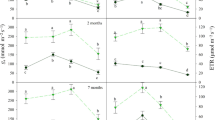Abstract
Lake Chicot, in south central Louisiana, USA, was created in 1943 by the impoundment of Chicot Bayou. Extensive establishment of woody seedlings occurred in the lake during a 1.5 year period, including the growing seasons of both 1986 and 1987, when the reservoir was drained for repair work on the dam. Study plots were established in September 1986 to document woody vegetation establishment and to provide a baseline by which to monitor survival and growth after flooding resumed.Taxodium distichum seedlings were the dominant species after one growing season, with a maximum density of 50 seedlings/m2, an average of about 2/m2, and an average height of 75 cm. The lake was reflooded at the end of 1987, bringing water depths at the study plots up to about 1.4 m. Temporary drawdowns were again conducted during the fall of 1992 and 1996. In December 1992, the site was revisited, new plots established, and saplings counted and measured. There was an average of 2.1T. distichum stems/m2, and the average height was 315 cm. After the 1996 growing season, there was still an average of about 1.9 stems/m2, and the average height had increased to 476 cm. Preservation ofT. distichum forests in relatively shallow but continuously flooded areas such as Lake Chicot may be a simple matter of draining the lake after a good seed crop and maintaining the drawdown long enough for the seedlings to grow taller than the typical growing season water level. In the case of Lake Chicot, this period was two growing seasons. This action will mimic natural, drought-related drawdowns of the lake and will allow the seedlings to establish themselves and grow tall enough to survive normal lake water levels.
Similar content being viewed by others
Literature Cited
Conner, W. H. 1993. Cypress regeneration in coastal Louisiana and the impact of nutria upon seedlings survival. p. 130–136.In M. C. Landin (ed.) Wetlands: Proceedings of the 13th Annual Conference of the Society of Wetland Scientists, New Orleans, LA., South Central Chapter, Society of Wetland Scientists, Utica, MS, USA.
Conner, W. H., J. R. Toliver, and F. H. Sklar. 1986. Natural regeneration of cypress in a Louisiana swamp. Forest Ecology and Management 14:305–317.
Cook, S. and K. C. Ewel. 1992. Regeneration in burned cypress swamps. Florida Scientist 55:62–64.
Demaree, D. 1932. Submerging experiments withTaxodium. Ecology 13:258–262.
Dicke, S. G. and J. R. Toliver. 1988. Effects of crown thinning on baldcypress height, diameter, and volume growth. Southern Journal of Applied Forestry 12:252–256.
Eggler, W. A. and W. G. Moore. 1961. The vegetation of Lake Chicot, Louisiana, after eighteen years impoundment. The Southwestern Naturalist 6:175–183.
Faulkner, P., F. Zeringue, and J. Toliver. 1985. Genetic variation among open-pollinated families of baldcypress seedlings planted on two different sites. p. 267–272.In Proceedings of the Eighteenth Southern Forest Tree Improvement Conference, Long Beach, MS, USA, Sponsored Publication No. 40.
Gooch, F. S. 1953. Nursery culture of cypress. Southern Lumberman 186:37–38.
Johnson, R. L. 1990.Nyssa aquatica L. Water tupelo. p. 474–478.In R. M. Burns and B. H. Honkala (tech. coords.). Silvies of North America. Volume 2, Hardwoods. USDA Forest Service, Washington, DC, USA. Agriculture Handbook 654.
Jones, C. G., J. R. Aldrich, and M. S. Blum. 1981. Baldcypress (Taxodium distichum) allelochemics and the inhibition of silkworm (Bombyx mori) enteric microorganisms: some ecologic considerations. Journal of Chemical Ecology 7:103–114.
Keeland, B. D., M. A. Townson, and J. A. Allen. 1996. Effects of flooding and herbivory on baldcypress seedlings planted at Caddo Lake, TX: First year results. p. 44–48.In K. M. Flynn (ed.) Proceedings of the Southern Forested Wetlands Ecology and Management Conference. Consortium for Research on Southern Forested Wetlands, Clemson University, Clemson, SC, USA.
Krinard, R. M. 1959. No advantage to clipping baldcypress planting stock. Tree Planters’ Notes 36:14.
Krinard, R. M. and R. L. Johnson. 1976. 21-Year growth and development of baldcypress planted on a flood-prone site. United States Department of Agriculture. Forest Service, Southern Forest Experiment Station, New Orleans, LA, USA. Research Note SO-217.
Krinard, R. M. and R. L. Johnson. 1987. Growth of 31-year-old baldcypress plantation. United States Department of Agriculture, Forest Service, Southern Forest Experiment Station, New Orleans, LA, USA. Research Note SO-339.
Mattoon, W. R. 1915. The southern cypress. United States Department of Agriculture. Washington, DC, USA. Bulletin No. 272.
Parresol, B. R. 1992. Baldcypress height-diameter equations and their prediction confidence intervals. Canadian Journal of Forest Research 22:1429–1434.
Penfound, W. T. 1949. Vegetation of Lake Chicot, Louisiana in relation to wildlife resources. Proceedings of the Louisiana Academy of Science 12:47–56.
Putnam, J. A., G. M. Furnival, and J. S. McKnight. 1960. Management and inventory of southern hardwoods. United States Department of Agriculture, Forest Service, Washington, DC, USA. Agriculture Handbook, No. 181.
Rathborne, J. C. 1951. Cypress reforestation. Southern Lumberman 183:239–240.
Rich, J. R. and C. H. Hodge. 1993. Utilization of blue crab scrap compost to suppressMeloidogyne javaniva on tomato. Nematropica 23:1–5.
SAS Institute, Inc. 1995. The SAS system for windows, Release 6.11. SAS Institute Inc., Cary NC, USA.
Silker, T. H. 1948. Planting of water-tolerant trees along margins of fluctuating-level reservoirs. Iowa College Journal of Science 22: 431–447.
Wilhite, L. P. and J. R. Toliver. 1990.Taxodium distichum (L.) Rich. Baldcypress. p. 563–572.In R. M. Burns and B. H. Honkala (tech. coords.) Silvies of North America, Volume 1, Conifers. United States Department of Agriculture, Forest Service, Washington, DC, USA. Agriculture Handbook 654.
Yoda, K., T. Kira, H. Ogawa, and K. Hozumi. 1963. Self-thinning in overcrowded pure stands under cultivated and natural conditions (Intraspecific competition among higher plants XI). Journal of the Institute of Polytechnics, Osaka City University, Series D 14:107–129.
Author information
Authors and Affiliations
Rights and permissions
About this article
Cite this article
Keeland, B.D., Conner, W.H. Natural regeneration and growth ofTaxodium distichum (L.) Rich. in Lake Chicot, Louisiana after 44 years of flooding. Wetlands 19, 149–155 (1999). https://doi.org/10.1007/BF03161743
Received:
Revised:
Accepted:
Issue Date:
DOI: https://doi.org/10.1007/BF03161743




